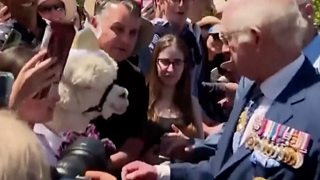Not my King, Australian senator shouts at King Charles

King Charles faced shouts of “you are not my King” from an independent senator just after he finished an address at Australia’s Parliament House on the second official day of his engagements in the country.
Lidia Thorpe, an Aboriginal Australian woman, interrupted the ceremony in the capital city of Canberra by shouting for about a minute before she was escorted away by security.
After making claims of genocide against “our people”, she could be heard yelling: “This is not your land, you are not my King.”
But Aboriginal elder Aunty Violet Sheridan, who had earlier welcomed the King and Queen, said Thorpe’s protest was “disrespectful”, adding: “She does not speak for me.”
 EPA
EPAThe ceremony concluded without any reference to the incident, and the royal couple proceeded to meet hundreds of people who had waited outside to greet them.
Australia is a Commonwealth country where the King serves as the head of state, but recently there has been debate about removing the monarch from the role.
Thorpe, who is an independent senator from Victoria, has long advocated for a treaty between Australia’s government and its first inhabitants.
Australia is the only ex-British colony without one, and many Aboriginal and Torres Strait Islander people emphasise that they never ceded their sovereignty or land to the Crown.
Afterwards, Thorpe told the BBC she had wanted to send a “clear message” to the King.
“To be sovereign you have to be of the land,” she said. “He is not of this land.”
She said the King needed to instruct the Parliament to discuss a peace treaty with the first peoples.
“We can lead that, we can do that, we can be a better country – but we cannot bow to the coloniser, whose ancestors he spoke about in there are responsible for mass murder and mass genocide.”
Thorpe, who was wearing a traditional possum skin cloak, described the late Queen Elizabeth II as “colonising” and was made to repeat her oath when she was sworn in as a senator in 2022.
There has been a long-held debate on how to tackle the glaring disparities between First Nations people and the wider population, including poorer health, wealth and education outcomes.
 Reuters
ReutersAboriginal Australians: ‘Could the Queen have done more?’
Australia weighs its future ahead of royal visit
Despite the protest, many others were happy to see the royals, with people queueing outside Parliament House all morning in the punishing Canberra sun, waving Australian flags.
Jamie Karpas, 20, said she did not realise the royal couple were visiting on Monday, adding: “As someone who saw Harry and Meghan the last time they were here, I’m very excited. I think the Royal Family are part of the Australian culture. They are a big part of our lives.”
Meanwhile, CJ Adams, a US-Australian student at the Australian National University, said: “He’s the head of state of the British empire right – you’ve got to take the experiences you can get while in Canberra.”
A small number of dissenters had also gathered on the lawn in front of the Parliament House building.

The royal visit to Canberra was always going to touch on Australia’s history with its Indigenous peoples, but Thorpe’s intervention meant the King and Queen faced it more directly than initially planned.
The King and Queen had arrived in Canberra earlier in the day and were greeted by a reception line of politicians, schoolchildren and Ngunnawal Elder Aunty Serena Williams, a representative of the Indigenous people.
They were given a traditional welcome into the Great Hall of Canberra’s Parliament House to the sound of a digeridoo.
The King spoke about indigenous communities and what he had learnt from them saying his own experience had been “shaped and strengthened by such traditional wisdom”.
“In my many visits to Australia, I have witnessed the courage and hope that have guided the nation’s long and sometimes difficult journey towards reconciliation,” he said.
But as he sat down, the shouts of Thorpe’s protest rang around the hall.
Her intervention was criticised by Aunty Sheridan, the Aboriginal elder who delivered part of the official welcome speech for the King and Queen in Parliament House.
She told the BBC: “The King’s not well. He’s going through chemo and he didn’t need this.
“I surely appreciate him visiting here. It may be the last time he comes. Heaps of people share my thoughts.”
Buckingham Palace has made no official comment on Thorpe’s protest, instead focussing on the crowds who had turned up to see the King and Queen in Canberra.
A palace source said that the royal couple were deeply touched by the many thousands who had turned out to support them.

Polls suggest support for the movement has grown since then, and the country’s Prime Minister Anthony Albanese, who shook the King’s hand just before the senator’s intervention, is a long-term republican.
However, Albanese’s government has ruled out holding a second vote on the issue anytime soon, following an unsuccessful referendum on Indigenous recognition last year.
King Charles’s visit – in a year in which he has been receiving cancer treatment – is his first to Australia since succeeding his mother Queen Elizabeth II. Because of his health, the tour is shorter than previous royal visits.
A lighter moment came earlier in the day when the King petted an alpaca who was wearing a small crown, when he stopped to talk to members of the public after a visit to Canberra’s war memorial.
The royal couple also planted trees at Government House before the King, a long-term environmentalist, visited the National Bushfire Behaviour Research Laboratory.
 PA Media
PA Media EPA
EPA





